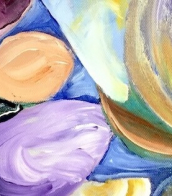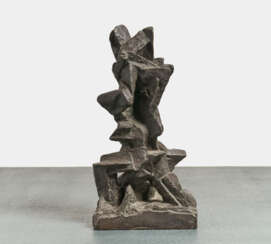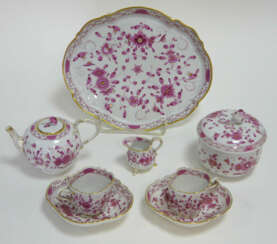eun nim

Eun Nim Ro is a South Korean artist who has worked in Germany.
She moved to Germany as a nurse in 1970, where she had the opportunity to exhibit her first works and receive art education. Eun Nim Ro developed an intuitive style of painting that combined Korean brush and ink drawings with the expressiveness of Western art. Naively drawn signs of fish, birds, trees and human figures became the artist's symbols. Eun Nim Ro's creative work is not limited to painting, she has also worked in other disciplines such as performance, calligraphy, painting, ceramics or installation. She has designed the windows of St. Johannes Church in Altona, among others, as well as light walls for government buildings in Seoul.
In 1990, Eun Nim Ro took up a professorship at the Hamburg University of Applied Sciences. In 1995, the artist became an honorary citizen of Seoul, and in 2015 she was also awarded the title of professor in Korea.


Eun Nim Ro is a South Korean artist who has worked in Germany.
She moved to Germany as a nurse in 1970, where she had the opportunity to exhibit her first works and receive art education. Eun Nim Ro developed an intuitive style of painting that combined Korean brush and ink drawings with the expressiveness of Western art. Naively drawn signs of fish, birds, trees and human figures became the artist's symbols. Eun Nim Ro's creative work is not limited to painting, she has also worked in other disciplines such as performance, calligraphy, painting, ceramics or installation. She has designed the windows of St. Johannes Church in Altona, among others, as well as light walls for government buildings in Seoul.
In 1990, Eun Nim Ro took up a professorship at the Hamburg University of Applied Sciences. In 1995, the artist became an honorary citizen of Seoul, and in 2015 she was also awarded the title of professor in Korea.


Eun Nim Ro is a South Korean artist who has worked in Germany.
She moved to Germany as a nurse in 1970, where she had the opportunity to exhibit her first works and receive art education. Eun Nim Ro developed an intuitive style of painting that combined Korean brush and ink drawings with the expressiveness of Western art. Naively drawn signs of fish, birds, trees and human figures became the artist's symbols. Eun Nim Ro's creative work is not limited to painting, she has also worked in other disciplines such as performance, calligraphy, painting, ceramics or installation. She has designed the windows of St. Johannes Church in Altona, among others, as well as light walls for government buildings in Seoul.
In 1990, Eun Nim Ro took up a professorship at the Hamburg University of Applied Sciences. In 1995, the artist became an honorary citizen of Seoul, and in 2015 she was also awarded the title of professor in Korea.


Henri Matisse, a renowned French visual artist, was celebrated for his vibrant use of color and fluid, original draughtsmanship. Born on December 31, 1869, in Le Cateau-Cambrésis, France, Matisse initially pursued a career in law before turning to art. He first began painting in 1889, a change inspired by convalescence art supplies his mother provided. This marked the beginning of a journey that would see him become a leading figure in modern art.
Matisse's career is notable for its stylistic evolution yet consistent aim to capture the "essential character of things." His early works, characterized by intense colorism, earned him recognition as one of the Fauves, or "wild beasts." The period from 1908 to 1913 was marked by significant developments, with works like "Reclining Odalisque" and "The Red Studio" showcasing his mastery in balance and serenity. In the 1920s, his style evolved to more relaxed forms, with a focus on light, color, and decorative patterns in paintings like his odalisque series.
Matisse's exploration of various mediums, including sculpture and paper collage, reflects his innovative spirit. His later years were dominated by cut paper collages, as health challenges limited his ability to paint. These works, alongside his bold drawings and sculptures, cemented his status as a pioneer in visual art.
For collectors and art experts, Matisse's work remains a testament to creative evolution and expressive use of color and form. His masterpieces can be found in prominent museums and galleries worldwide, continuing to inspire and fascinate art enthusiasts.
To stay updated on new product sales and auction events related to Henri Matisse's art, sign up for our updates. This subscription will keep you informed about opportunities to appreciate and acquire works connected to this iconic artist.



Jim Dine is an American artist whose œuvre extends over sixty years. Dine’s work includes painting, drawing, printmaking (in many forms including lithographs, etchings, gravure, intaglio, woodcuts, letterpress and linocuts), sculpture and photography; his early works encompassed assemblage and happenings, while in recent years his poetry output, both in publications and readings, has increased.

.jpg)
Maurice de Vlaminck was a French artist renowned for his vibrant use of color and contribution to the Fauvist movement. Born in Paris in 1876, Vlaminck's early work was marked by a passionate application of paint and a bold palette, drawing inspiration from Vincent van Gogh and Henri Matisse. His participation in the 1905 Salon d'Automne, alongside other Fauvist painters, was met with critical disdain, leading to the term "fauves" (wild beasts) being coined to describe their unorthodox use of intense color.
Vlaminck's career was characterized by a continuous exploration of color and form. Early on, he depicted scenes of daily life, landscapes, and portraits, imbuing them with a sense of motion through his dynamic brushwork. Notable works from this period include "Sur le zinc" (At the Bar) and "L'homme a la pipe" (Man Smoking a Pipe), which highlighted his departure from traditional portraiture and landscapes towards more expressive and mood-driven compositions. His landscapes, in particular, showcased a disregard for detail in favor of conveying atmosphere, a technique that was revolutionary at the time.
Throughout his life, Vlaminck's style evolved, showing influences from Post-Impressionism and later, a more monochromatic palette reminiscent of Paul Cézanne. Despite this evolution, he maintained a critical stance towards Cubism and its leading figure, Pablo Picasso, believing that Cubism had led French painting into a "wretched dead end". In his later years, Vlaminck's work adopted a darker palette and more naturalistic style, moving away from the Fauvist emphasis on color to explore the dramatic and expressive potential of landscapes and seascapes.
Vlaminck's impact on modern art is undeniable. His works are held in prestigious collections worldwide, including the Hermitage Museum in Saint Petersburg and the Minneapolis Institute of Art, attesting to his enduring influence and the continued fascination with his bold, expressive approach to painting.
For collectors and experts in art and antiques, Vlaminck's oeuvre represents a pivotal moment in the history of modern art, where the emotional intensity and visual impact of color were explored as never before. To stay informed on new product sales and auction events related to Maurice de Vlaminck, signing up for updates is recommended, offering exclusive insights into the vibrant world of Fauvism and modernist painting.

 Серж Поляков. Фотопортрет художника.jpg)
Serge Poliakoff was a Russian-born French modernist painter belonging to the 'New' Ecole de Paris (Tachisme).


Pieter Stevens the Younger was a Flemish painter and draughtsman known for his landscapes. He left Flanders to work for the court of Emperor Rudolf II in Prague. The circulation of prints made after a series of romantic Bohemian landscape drawings by Stevens and other artists had an important influence on the development of Flemish and Dutch landscape art in the 17th century.

















































































